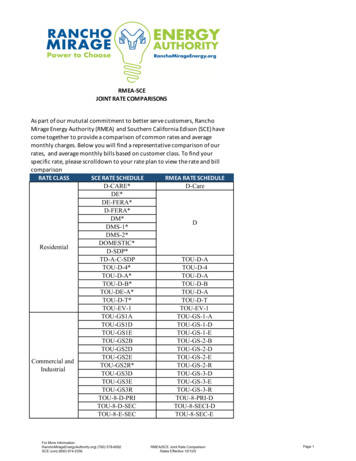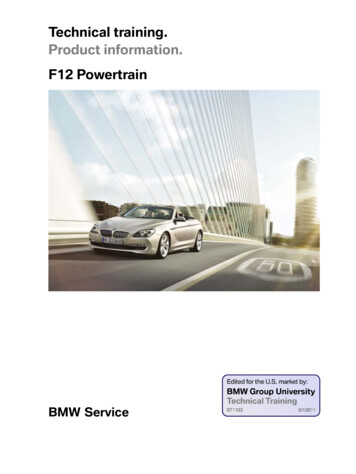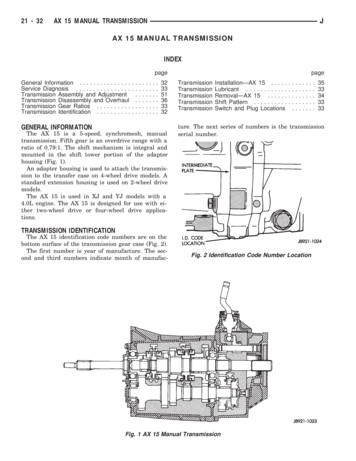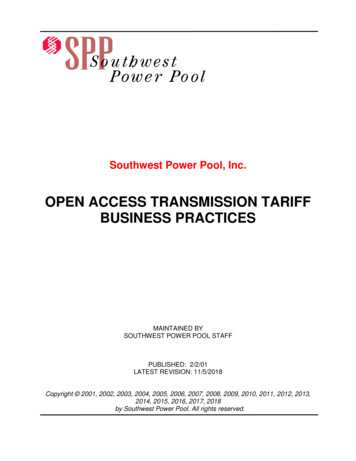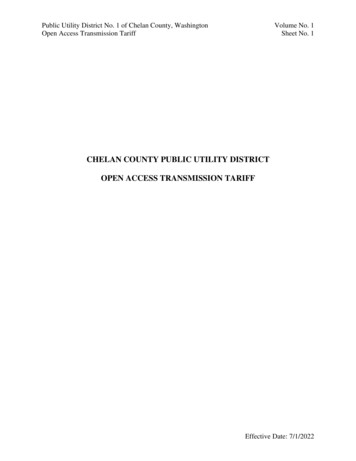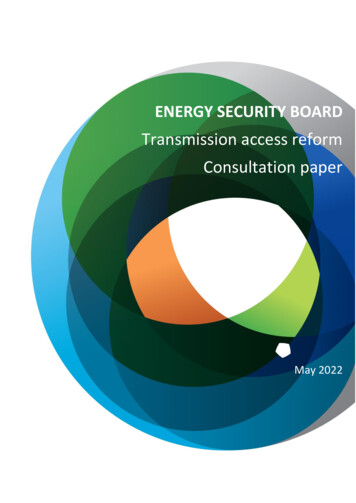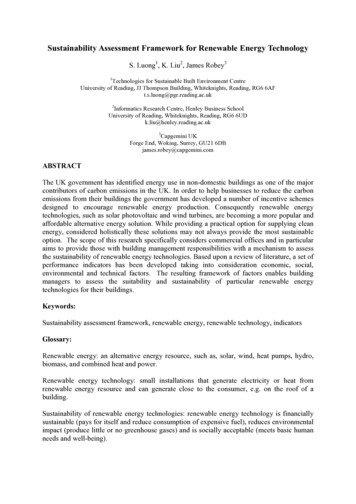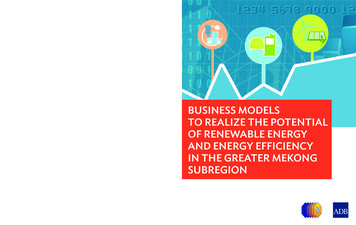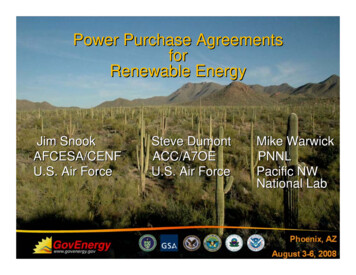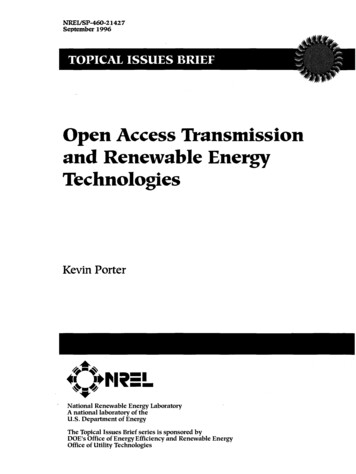
Transcription
NREUSP-460-21427September 1996Open Access Transmissionand Renewable EnergyTechnologiesKevin PorterNational Renewable Energy LaboratoryA national laboratory of theU.S. Department of EnergyThe Topical Issues Brief series is sponsored byDOE's Office of Energy Efficiency and Renewable EnergyOffice of Utility Technologies
NoticeThis report was prepared as an account of work sponsored by an agency of the United States government. Neither the United Statesgovernment nor any agency thereof, nor any of their employees, makes any warranty, express or implied, or assumes any legalliability or responsibility for the accuracy, completeness, or usefulness of any information, apparatus, product, or process disclosed,or represents that its use would not infringe privately owned rights. Reference herein to any specific commercial product, process, orservice by trade name, trademark, manufacturer, or otherwise does not necessarily constitute or imply its endorsement,recommendation, or favoring by the United States government or any agency thereof. T he views and opinions of authors expressedherein do not necessarily state or reflect those of the United States government or any agency thereof.Printed in the United States of AmericaAvailable to DOE and DOE contractors from:Office of Scientific and Technical Information (OSTI)P.O. Box 62Oak Ridge, TN 37831Prices are available by calling (423) 576-8401Available from:National Technical Information ServiceU.S. Department of Commerce5285 Port Royal RoadSpringfield, VA 22161(703) 487-4650Information pertaining to the pricing codes can be found in the current issue of the following publications which are generally availablein most libraries: Government Reports Announcements and Index (GRA and I); Scientific and Technical Abstract Reports (STAR); andpublication NTIS-PR-360 available from NTIS at the above address.
NREUSP-460-21427September 1996Open Access Transmissionand Rene\Vable EnergyTechnologiesKevin PorterPrepared for:Office of Utility TechnologiesEnergy Efficiency and Renewable EnergyU.S. Department of Energy.· . -·. .·,!!1-1-- Center for Energy Analysis and ApplicationsNational Renewable Energy LaboratoryGolden, Colorado 80401-3393Operated by Midwest Research Institutefor the U.S. Department of Energy
Contents )I.II.Abstract . . . . . . . . . . . . . . . . . . . . . . . . . . . . . . . . . . . . . . . . . . . . . . . . . . . . . . . . . . . . . . . . . . . . . . . . . . . . . . . . . . . . . . . . . . . . . . . . . . . . . . . . . . . . . . . . . . . . . . . . . . . . . . . . . ivIntroduction.1. .Order No. 888 in Brief.The Tariffs . . . . . . . . . . . . . . . . . . . .Reciprocity . . . . . . . . . . . . . . . . . . . . . . . . . . . . . . . . . . . . . . . . . . . . . . . . . . . . . . . . . . . . . . . . . . . . . . . . . . . . . . . . . . . . . . . . . . . . . . . . . . . . . . . . . .Federal-State Jurisdiction . . .Ancillary Services . . . . . . . . . . . . . . . . . . . . . . . . . . . . . . . . . . . . . . . . . . . . . . . . . . . . . . . . . . . . . . . . .Independent System Operators . .Reassignment . . . . . . . . . . . . . . .Regional Practices . :. . . . . . . . . . .III .Implications for Renewable Energy . .Transmission PricingFlexible Transmission Terms and Conditions.Reassignment. . . .Functional Test for Distribution and Transmission .Ancillary Services.Reciprocity.Regional Practices. . . . . . . . . . . . . . . . . . . .IV.SummaryV.Notes. .Appendix A: Independent System Operators.Appendix B : The Environmental Impact StatementNotes t o Appendix. . . . .566778889. . . . 1 1.4.11223444. .Open Access Transmission and Renewable Energy Technologies 1112iii
AbstractIn April 1996, the Federal Regulatory Com mission (PERC) approved Orders 888 and 889 and re leased a draft rule for public comment on capacity res ervation tariffs (CRTs). Order No. 888 requires elec tric utilities to file transmission tariffs that would allowtransmission access to third parties who want to con duct wholesale transactions. The order also allows utili ties, under certain conditions, to directly collect thestranded costs (i.e., costs for power priced above mar ket prices that cannot be recovered) from wholesale cus tomers who tum to other suppliers. Order No. 889 re quires transmission-owning utilities to set up open ac cess, same-time information systems (OASIS), usingcommercial software and Internet protocols. The orderalso requires transmitting utilities to enact codes of con duct, which require utilities to separate the marketingand merchant employees from transmission and reliabil ity employees. Utilities must also post market informa tion and discounts simultaneously to all parties. FERCalso proposes to replace the pro forma tariffs in OrderNo. 888 with CRTs, to eliminate the distinction betweennetwork service (which is generally priced and based onthe load of a transmission-dependent utility) and capac ity-based point-to-point service.Order 888 makes open access transmission anofficial FERC policy and ends decades of debate overwhether electric utilities should be required to offer openaccess transmission. With Order 888, renewable en ergy interests, which fought long and hard for the lim ited open access transmission provisions in the EnergyPolicy Act 1992, can use transmission to access marketopportunities beyond the nearest utility. How benefi cial open access transmission ultimately is forrenewables, however, depends on variables beyond thefmal rule, such as how the electric power market reactsto it. Open access transmission could vastly increasethe number of buyers and sellers, increasing competi tion and exerting a downward pressure on electricityprices. New market players, such as power marketersand brokers, are emerging, further diversifying the elec tric power market. Although renewables may be ableto access more markets, they may face stiff competitionfor those markets.Additionally, how FERC implements Order 888,as well as the terms, rates, and conditions of transmis sion, will determine whether renewables can take ad vantage of open access transmission. PERC primarilyacts on individual cases and filings. Each case willpresent specific facts and circumstances that will pro vide FERC the opportunity to more sharply define howit will treat some of the areas FERC broadly acted uponin Order 888. Some of the issues before FERC withimplications for renewables include: transmission pric ing; transmission terms and conditions; reassignmentof transmission capacity; defming state and FERC ju risdiction over transmission and distribution; the pric ing of ancillary services; and the adoption and imple mentation of independent system operators.Open Access Transmission and Renewable En ergy Technologies was prepared by the Center for En ergy Applications and Analysis for the Office of UtilityTechnologies (OUT) of the U.S. Department of Energy(DOE). The author wishes to thank Joseph Galdo ofOUT for providing funding support and Larry Goldsteinof the National Renewable Energy Laboratory (NREL)for his assistance in shaping and managing the project.The author also thanks Joseph Galdo; Larry Goldstein;Richard Scheer of Energetics; Diane Pirkey of the Com petitive Resource Strategies Program in OUT; and LarryMansueti of OUT for providing comments on early draftsof this paper. Finally, the author thanks the followingfor reviewing fmal drafts of this paper: Paul Galen,Karin Sinclair, and Scott Wright ofNREL; Charles Grayof the National Association of Regulatory Utility Com missioners; ScottHempling, an attorney in Silver Spring,Maryland; EricHirst of the Oak Ridge National Labo ratory; Karl Rabago of the Environmental Defense Fund;Terry Black of Project for the Sustainable FERC En ergy Policy; Ken Linder and David Dworzak of theEdison Electric Institute; Bill Cowan of the NationalIndependent Energy Producers; Tom Rosenberg of Bio mass Energy Alliance; and Mac Moore of the SolarEnergy Industries Association.Open Access Transmission and Renewable Energy Technologies v
Open Access Transmission andRenewable Energy Technologies )I. IntroductionIn April 1996, the Federal Energy RegulatoryFinally, PERC proposes to replace the pro formatariffs in Order No. 888 with CRTs. The proposed rulewould eliminate the distinction between network ser Commission (FERC) culminated a year-long rulemakingvice, which is generally priced and based on the load ofby releasing Order No. 888 and Order No. 889, as wella transmission-dependent utility, and capacity-basedas a draft rule on capacity reservation tariffs (CRTs).point-to-point service. The proposed rule also requestsTo do so, PERC sifted through 400 comments totalingcomments on whether the different (and sometimes con 20,000 pages that poured in after PERC released a draftflicting) network and point-to-point transmission ser rule, sometimes known as "the mega-NOPR" (Noticevice can be replaced with a single system devoted toof Proposed Rulemaking), in March 1995. All told, thecapacity definition and reservation.2 Space restrictionstwo orders and the CRTs total more than 1,000 pages.1will confine most of this paper's discussion to OrderNo. 888, which is sometimes referred to as "the finalOrder No. 888 directs electric utilities to filerule" in this paper.transmission tariffs at PERC to allow transmission ac cess to third parties who want to conduct wholesale trans This paper summarizes the major highlights ofactions. The order also requires utilities to offer trans Order No. 888 and explores its implications for renew mission customers "comparable service"; i.e., offer themable energy technologies. It also examines some of thethe same or equivalent terms and conditions a utilitycomments filed by renewable energy and environmentalhas when it uses its transmission system. The orderorganizations, and assesses PERC's ultimate decisionsalso allows utilities, under certain conditions, to directlyin the areas those groups commented on. Although thecollect the "stranded costs" (i.e., costs for power pricedorder grants transmission access, it lays out broad pa above market prices that cannot be recovered) fromrameters in several areas that will be implemented onwholesale customers who tum to other suppliers. Ina case-by-case basis. These cases, and other issues theaddition, the order requires rural cooperatives, govern rule did not directly address such as transmission pric ment-owned, and municipal utilities (typically not regu ing, will determine the final rule's ultimate impact onlated by PERC) to provide reciprocal transmission ac renewable energy technologies.cess to transmission-owning utilities if they take advan tage of open access transmission tariffs. The order alsostates that PERC has jurisdiction over wholesale andunbundled retail transmission, but PERC will defer tostate recommendations as long as a state uses the seventests PERC developed to distinguish between PERC regulated transmission and state-regulated distribution.Order No. 889 requires transmission-owningutilities to set up "open access, same-time informationsystems" (OASIS), using commercial software andInternet protocols. It also requires transmitting utilitiesto enact "codes of conduct," which require them to sepa rate the marketing and merchant employees from trans mission and reliability employees. Utilities must alsopost market information and discounts simultaneouslyto all parties.II. Order No. 888 in Brief3The TariffsA primary requirement is that "public utilities"under the Federal Power Act (FPA), mostly investor owned utilities, must have an open access transmissiontariff on file at PERC that offers the same or superiorterms and conditions as a pro forma tariff that PERCincluded with the final rule. The tariff must offer trans mission services comparable to those a transmissionowner provides itself, which is known as PERC's "com parability standard." Utilities must offer point-to-pointand network service and charge the same transmissionrates or apply for new rates in a separate filing. Powerpools must remove member-preferential access and pric ing provisions and offer comparable terms and condi-Open Access Transmission and Renewable Energy Technologies 1
tions to all transmission customers. Utilities must alsopractice "functional unbundling," meaning they must:Various court cases have given FERC jurisdiction overalmost all transmission, including transmission trans actions that occur wholly inside state boundaries, on Take transmission and artcillary ser vices for all new wholesale sales and purchasesthe grounds that transmission electrons could cross statelines while the transaction is consummated.under the same tariff terms and conditions astheir transmission customers State separate rates for wholesale gen eration, transmission, and ancillary services Use the same electronic informationnetwork as their transmission customers whenobtaining information about their transmissionsystems.ReciprocityFERC has jurisdiction over "public utilities,"which transmit electric power in interstate commerce,and/or sell electric power at wholesale in interstate com With greater wholesale competition in the elec tric power industry, and the growing prospect of retailcompetition, customers may receive transmission andgeneration from various entities. Customers will usecompetition among power generators to select theirpower supply, then use a utility's transmission systemto deliver the power. In essence, the former bundledtransaction of generation and transmission has changedto an unbundled transaction, in which a customer usesvarious sources to provide transmission and generationinstead of just one source (the utility). Often, the utilitythat provides the transmission is the former supplier ofthe bundled transaction.merce. This means FERC has jurisdiction over- inves tor-owned utilities that own more than 70% of the trans mission lines in the United States but generally not overrural electric cooperatives, municipal utilities, or fed eral power systems like the Bonneville Power Adminis tration (BPA).4 In addition, Section 201 of the FPAspecifically bars FERC from regulating a state or fed eral subdivision, agency, or authority.5To avoid creating a "patchwork" of transmis sion access and nontransmission access utilities, Order888 requires that nonjurisdictional utilities offer openaccess to PERC-jurisdictional utilities if they use an openWith this unbundling, a retail transaction isbroken into two products-electric energy and trans mission-that are sold separately. FERC believes thatstates have jurisdiction over the sale of electric power,but the retail unbundled transmission is done in inter state commerce. Consequently, over the objections ofmany states, FERC claimed jurisdiction over the rates,terms, and conditions of unbundled retail transmissionconducted in interstate commerce by PERC-jurisdic tional utilities, up to the point of local distribution (i.e.,where electricity is routed and distributed to the end orultimate consumer).access tariff, To prevent utilities from denying trans mission access because of reciprocity issues, FERC al lows nonjurisdictional utilities to submit a voluntarytariff and ask FERC for an order on whether the tariffmeets the reciprocity requirement. FERC said it willalso not require reciprocity if a utility's tax -exempt sta tus would be threatened by the private use of tax-ex empt facilities, but FERC also said it expects the Inter nal Revenue Service to rule on this issue soon.Federal-State JurisdictionHistorically, transmission has been included as part ofa wholesale power transaction between buyers and sell ers. This is often termed a ''bundled" transaction. TheFPA devised a "bright line" between FERC's jurisdic tion and state jurisdiction, which essentially gave FERCjurisdiction over wholesale power and interstate trans mission and states jurisdiction over retail transactions.2 OpenAccess TransmissionandRenewable Energy TechnologiesThree months after FERC issued Order 888,the U.S. Court of Appeals for the District of ColumbiaCircuit largely affirmed FERC's 1992 natural gas pipe line restructuring order, also known as Order 636. Thecourt upheld FERC's determination that FERC has ju risdiction over the interstate transportation componentof natural gas when the sale of gas is unbundled frominterstate transportation. The court said states retainauthority over sales of natural gas by local distributioncompanies to end-users. Because FERC considers theNatural Gas Act and the FPA to be sister statutes, FERCbelieves the court's ruling in this area to be directly ap plicable to the jurisdictional position it took in Order888.6
In Order 888, FERC further stated that there isnot a "bright line" separating unbundled retail trans mission and distribution and that this must be resolvedon a case-by-case basis. Therefore, FERC proposedseven indicators for distinguishing between transmis sion and distribution:( 1) Local distribution facilities are normally inclose proximity to retail customers.(2) Local distribution facilities are primar i 1 yradial in character.(3) Power flows into local distribution systems;it rarely, if ever, flows out.(4) When power enters a local distributionsystem, it is not reconsigned or transported to anothermarket.(5) Power that enters a local distribution sys tem is consumed in a comparatively restricted geographicarea.(6) Meters are based at the transmission/localdistribution interface to measure flows into the localdistribution system.(7) Local distribution systems will be of re duced voltage.For states that adopt a retail access program,FERC will defer to state recommendations on where todraw the boundary between transmission and distribu tion, and how to allocate costs for transmission and dis tribution between FERC and the states, as long as thestates use the seven indicators above. FERC also statedthat states have jurisdiction over the delivery of elec tricity to the ultimate consumer. Therefore, FERC be lieved states can assign charges to recover the costs ofstranded benefits and stranded investment based on us age, (kilowatt hours [kWh]), demand (kilowatts [kW])or any other method or combination.iffs. FERC said transmitting utilities may offer othertypes of ancillary services, and pricing for all ancillaryservices will be done on a case-by-case basis. The sixservices are:(1) Scheduling, system control, and dispatch,in which transmitting utilities schedule and coordinatetransmission transactions with other entities and con firm the power exchange in and out of their control ar eas.(2) Reactive supply and voltage control fromgeneration sources help maintain the proper transmis sion line voltage. This service involves using generat ing facilities to supply reactive power and voltage con trol and must be unbundled from basic transmissionrates.(3) Regulation andfrequency response is gen erated beyond the current system load requirements usedto follow the moment-to-moment variation in acustomer's demand or scheduled generation delivery, inorder to maintain frequency at 60 cycles per second(60Hz).(4) Energy imbalance corrects any hourly mis match (as opposed to instantaneous variations for regu lation and frequency response service) between a trans mission customer's energy supply and a load beingserved in a control area.(5) Operating reserve/spinning reserve and (6)operating reserve/supplemental reserve are defined asextra generation to serve load in case of an unplannedevent such as an outage of a major generation facility.Spinning reserve is generation that is on-line and oper ating at less than maximum output and can be ready toimmediately serve load. Supplemental reserve is gener ating capacity that can be used in emergency conditionsbut is not available immediately. Supplemental reservecapacity can be started up very quickly (usually within10 minutes).Although the transmitting utility must beequipped to offer all six services, FERC clarified thatonly the first two ancillary services (scheduling, systemAncillary Servicescontrol and dispatch, and reactive supply and voltagecontrolfrom generation services) must be offered to allAs transmission, generation, and distribution becomebasictransmissioncustomers. In addition, FERCruledunbundled, a number of services must be provided tothattransmissioncustomersmust buy the first two an ensure system reliability. FERC determined that sixcillaryservicesfromthetransmittingutility, because theancillary services must be included in open access tar Open Access Transmission and Renewable En ergy Technologies 3
services are local by nature, and the transmitting utilityis best suited to provide these services.thirds of its energy requirements. Utilities in the regionsaid they rely on non-finn transmission to either sellexcess hydropower during high water years or to pur Independent System Operatorschase non finn purchases from other suppliers duringlow water years. Utilities and state commissions in theThe electric power industry has increasinglyregion expressed concern that open access transmissionembraced the concept of an independent system opera would subordinate non-firm transmission transactionstor (ISO) taking control of a transmission system. Thereto firm transactions. If enough transmission customersare several variations of ISOs being proposed. In thereserved firm transmission capacity, utilities would notfinal rule, FERC adopted several principles for how itbe able to conduct the non-finn transactions the regionwill evaluate ISOs, which are provided in Appendix A.has historically relied on. These utilities and state com Among other findings, FERC said ISOs should be com missions asked to reserve some transmission capacitypletely independent of generation owners and provideto protect these non-finn transmission transactions.fair transmission access.FERC said it will allow utilities to modify tar Reassignmentiff terms to reflect prevailing regional practices, such asthe use of non-firm transmission to either sell excessHolders of point-to-point transmission servicehydropower or purchase non-firm power during lowcan reassign their capacity rights to eligible parties. Thewater years. FERC urged the parties to reach an agree original holder can conduct the transaction directly withment with other transmission customers in the region onthe assignee, but it remains obligated to the transmis the scheduling and dispatch of non-firm hydro and makesion provider. In addition, rates for capacity reassign that agreement part of utility tariffs to be filed at FERC.ment are capped at the higher end of the transmissionThe commission also encouraged utilities to reflect re rates charged by the transmission provider to the as gional conditions through the filing of regional trans signor, the transmission providers's maximum statedmission groups (RTGs) or ISOs.firm transmission rate in effect at the time of the trans action, or by the assignor's opportunity costs.Several parties expressed concern that trans mission customers may "hoard" transmission capacityor reserve capacity during times of peak customer de mand only. FERC, however, declined suggested policymeasures such as a "use it or lose it" system, "take orpay" charges, imposing nonrefundable fees, or impos ing limitations on how far in advance reservations fortransmission capacity can be made. FERC reasonedthat transmission customers will have an economic in centive to reassign unused transmission capacity. FERCalso said a transmitting utility is free to schedule andsell any unscheduled finn transmission capacity on·anon-firm basis. Finally, FERC said a complaint can befiled with FERC if there is evidence that a transmissioncustomer is hoarding transmission capacity.Ill. Implications for Renewable EnergyRenewable energy interests fought vigorouslyfor the transmission access provisions embodied in theEnergy Policy Act of 1992 (EPAct), and the greateravailability of open access transmission provided byOrder 888 may well be beneficial to, renewables. Re motely located renewable resources now may be able touse transmission systems to transport renewable elec tricity to the most favorable market, not simply to thenearest utility.Under the Public Utility Regulatory·Policies Act (PURPA), renewable generators sold powerto the nearest utility and hoped the avoided cost pay ment was high enough to justify going ahead with theproject. With open access, renewable generators maybe able to use transmission to sell power to any utilityor, in the advent of retail wheeling, any customer will Regional PracticesSome utilities and state commissions in the Pa cific Northwest protested that PERC's efforts to pro vide transmission access may unfairly discriminateagainst hydro-based utilities. These parties noted thatthe Pacific Northwest relies on hydro to meet about two4 OpenAccess TransmissionandRenewable Energy Technologiesing to pay the highest price. Indeed, if retail wheeling isadopted, renewables may be able to compete for mul tiple buyers rather than for a single utility.How beneficial open access transmission ulti mately is for renewables depends on variables beyondthe final rule, such as how the electric power market
reacts to open access transmission. Open access trans mission could vastly increase the number of buyers andsellers, increasing competition and exerting a downwardpressure on electricity prices. New market players, suchas power marketers and brokers, are emerging and fur ther diversifying the electric power market. Indeed, avibrant spot market is emerging in some parts of thecountry, especially the western United States whereshort-term and intermediate power is sold for 20-30mills/kWh. Although renewables may be able to accessmore markets, they may face stiff competition for thosemarkets.Additionally, how FERC implements Order 888,as well as the terms, rates, and conditions of transmis sion, will determine whether renewables can take ad vantage of open access transmission. Order 888 out lines broad policies and parameters in a number of keyissues such as ISOs and stranded cost recovery. How ever, FERC primarily acts on cases and filings broughtbefore it by parties in the electric power industry. Eachcase will present specific facts and circumstances thatwill provide FERC the opportunity to more sharply de fme how it will treat some of the areas FERC broadlyacted on in Order 888. This includes the issues de scribed below.capacity, as called for in the CRTs NOPR, may be morecompatible with the goal of some industry participantsto move toward flow-based transmission pricing.Transmission pricing is a critical issue for re newable technologies, because renewable power plants,particularly intermittent resources such as solar andwind, must be located where the renewable resource islocated. Simply put, the site-specific nature of certainrenewable technologies could make them captive to thetransmission location and price. If transmission pric ing is designed to encourage new generation to be lo cated to alleviate transmission congestion, it is mucheasier to move the raw fuels for a new fossil fuel plantthan for a renewable power plant.Future transmission pricing initiatives may alsofeature congestion pricing where, if the transmissionsystem is congested and there is more demand than avail able supply, a congestion charge may be added in addi tion to the transmission rate. Such a rate may encour age transmission customers to defer their transaction orre-route it (if possible) to a less congested transmissionline. Congestion charges may also encourage distrib uted generation such as photovoltaics (PV), fuel cells,and small cogeneration plants, which may help reinf
of transmission capacity; defming state and FERC ju risdiction over transmission and distribution; the pric ing of ancillary services; and the adoption and imple mentation of independent system operators. Open Access Transmission and Renewable En ergy Technologies was prepared by the Center for En


